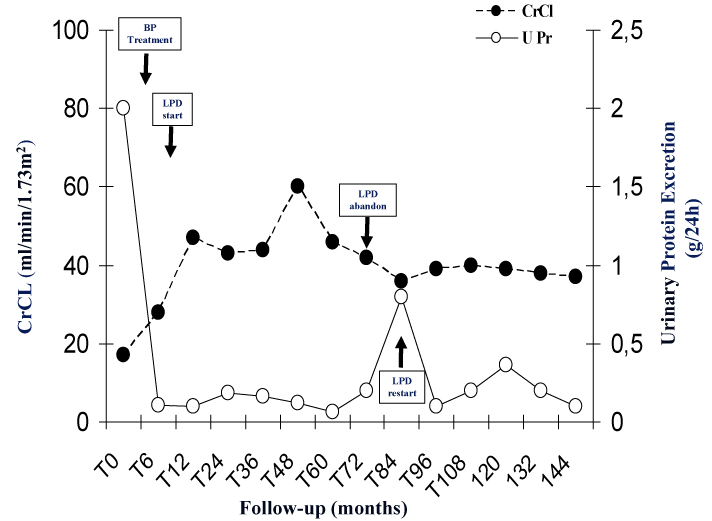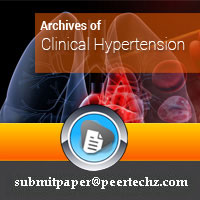Archives of Clinical Hypertension
Emergencies Hypertensive: A long term follow-up of renal function with pharmacological and Non Pharmacological therapy
Tiziana Ciarambino1* and Mauro Giordano2
2Department of Advanced Medical and Surgical Sciences, University of Campania “L. Vanvitelli”, Italy
Cite this as
Ciarambino T, Giordano M (2019) Emergencies Hypertensive: A long term follow-up of renal function with pharmacological and Non Pharmacological therapy. Arch Clin Hypertens 5(1): 001-002. DOI: 10.17352/ach.000020Background: Patients who experience emergencies (HEs) and urgencies (HUs) hypertensive are at high risk for developing clinical complications such as ischemic attack, acute renal injury, or any other ischemic organ damage.
Methods: We reported a case of 45 year-old female admitted to our Emergency Medicine Department for cefalea. The clinical characteristics at admission were: BP was 220/125 mmHg, HR 90 bpm, SO2 92% A.A., no fever, BMI 25 kg/m2. She received a treatment with intravenous labetalolo 20 mg BID, followed by 20 mg after 20 minutes. After about 6 hours she was asymptomatic and blood pressure was 150/90 mmHg. We invited to take enalapril 20 mg and she started low protein diet (LPD) (0.8 gr/Kg/day) at home.
Conclusion: Our approach might be to add pharmacological therapy with LPD for patient with HEs and acute renal failure. In fact, it has been reported that LPD retard the progression of renal failure.
Case Report
We describe a case of 45 year-old female admitted to our Emergency Medicine Department for cefalea. She also hasn’t a history of arterial hypertension or other disease. The clinical characteristics at admission are: BP was 220/125 mmHg, HR 90 bpm, SO2 92% A.A., no fever, BMI 25 kg/m2. The objective exam evaluation was negative. At admission she received a treatment with intravenous labetalolo 20 mg BID, followed by 20 mg after 20 minutes. The blood investigation showed a significantly increase of serum creatinine and BUN (+ 9% and +20%, respectively vs basal value). The urine analysis showed protein excretion equal to 1 gr day. The EKG analysis showed ventricular hypertrophy. After about 6 hours she was asymptomatic and blood pressure was 150/90 mmHg. The patient was discharged after 48 hours, stable, and with reduction of serum creatinine and serum BUN (- 9% and -12%, respectively vs admission). We invited to take enalapril 20 mg and she started low protein diet (LPD) (0.8 gr/Kg/day) at home. After 72 months, she decided to abandon LPD and at control we observed the reduction of Creatinine Clearance (about 40% vs T48, p< 0.01) and the increased of protein excretion (about 50% vs T48; p< 0.01). We invited her to restart LPD and successively we observed a significantly ameliorate of renal function with follow-up at the 144 months (Figure 1).
Discussion
Emergencies hypertensive (HEs) is described as severe hypertension (systolic blood pressure [BP] ≥180 mm Hg and/or diastolic BP ≥110 mm Hg) associated with signs or symptoms of acute organ damage [1]. The recommendation for HEs should be the reduction of the blood pressure by 25% to prevent clinical complications [2]. However, before the age of 45, women as compared with men have a lower incidence and prevalence of hypertension, a significant risk factor for cardiovascular disease (CVD); while, as women age, this risk increases [3]. One explanation for this age-related development of hypertension seen in women is postulated to involve the decline in estrogen levels after menopause, suggesting that the loss of estrogen unmasks hypertension in these women [4]. Salt sensitivity is another crucial aspect present in approximately half of those with essential hypertension [5] and it may enhance the risk of cardiovascular and kidney-related morbidity in these patients [6].
No data in literature reported the role of low protein diet (LPD) in renal function in emergencies hypertensive. It has been described that LPD may retard the progression of kidney injury [7-9]. Epidemiological evidence demonstrated that a dietary intake, with 0.8 g/day of protein per kg of ideal weight, could represent a substantial reduction of their habitual protein intake. In our patient a long-term LPD (after 144 months), as reported in Figure 1, has contribute to ameliorate the renal function and to decrease cardiovascular mortality. Futury studies are necessary to confirm the use of LPD, added to pharmacological therapy, in follow up for patients with HEs.
- Kearney PM, Whelton M, Reynolds K, Muntner P, Whelton PK, et al. (2005) Global burden of hypertension: analysis of worldwide data. Lancet 365: 217-223. Link: https://tinyurl.com/y26445n5
- Clement D, Williams B, Mancia G, Spiering W, Rosei EA, et al. (2018) 2018 ESC/ESH Guidelines for the management of arterial hypertension. European Heart Journal 39: 3021-3104. Link: https://tinyurl.com/yczntwzn
- Go AS, Mozaffarian D, Roger VL, Benjamin EJ, Berry JD, et al. (2013) American Heart Association Statistics Committee and Stroke Statistics Subcommittee. Heart disease and stroke statistics a report from the American Heart Association. Circulation 127: e6–e245. Link: https://tinyurl.com/y3kwhxsd
- Peter I, Shearman AM, Zucker DR, Schmid CH, Demissie S, et al. (2005) Variation in estrogen-related genes and cross-sectional and longitudinal blood pressure in the Framingham Heart Study. J Hypertens 23: 2193-2200. Link: https://tinyurl.com/y5ak2u4a
- Williams GH, Hollenberg NK (1989) Sodium-sensitive essential hypertension: emerging insights into an old entity. J Am Coll Nutr 8: 490–494. Link: https://tinyurl.com/y69fcp3b
- Campese VM (1994) Salt sensitivity in hypertension. Renal and cardiovascular implications. Hypertension 23: 531–550. Link: https://tinyurl.com/y5hufz9j
- King AJ, Levey AS (1993) Dietary protein and renal function. J Am Soc Nephrol 3: 1723-1737. Link: https://tinyurl.com/y2jovuy6
- De Santo NG, Perna A, Cirillo M (2011) Low protein diets are mainstay for management of chronic kidney disease. Front Biosci 3: 1432-1442. Link: https://tinyurl.com/y2yyqzxy
- Giordano M, Ciarambino T, Castellino P, Cataliotti A, Malatino L, et al. (2014) Long-term effects of moderate protein diet on renal function and low-grade inflammation in older adults with type 2 diabetes and chronic kidney disease. Nutrition 30: 1045-1049. Link: https://tinyurl.com/y5zrw6l4
Article Alerts
Subscribe to our articles alerts and stay tuned.
 This work is licensed under a Creative Commons Attribution 4.0 International License.
This work is licensed under a Creative Commons Attribution 4.0 International License.


 Save to Mendeley
Save to Mendeley
